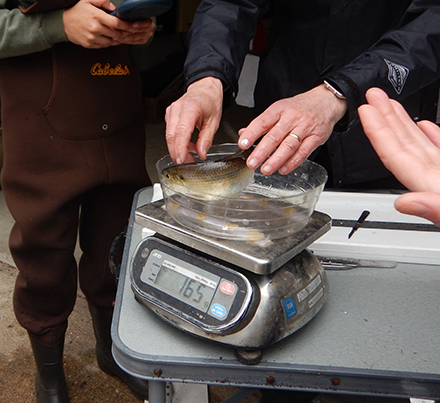Alewife on the Move
Hofstra University scientists weigh an adult alewife last month prior to releasing it into Beaver Lake in Mill Neck, Long Island. About 200 fish were weighed, measured for length, identified by sex, and given Passive Integrated Transponder (PIT) tags just under their skin as part of a stocking and monitoring project where populations are expected to improve thanks to the completion of a fishway built in 2017. The tagged fish will spawn in the lake and leave the system within days of spawning. It is anticipated that they will return to their native waters in the Peconic River next spring as part of its annual migratory run. But the offspring, after leaving Beaver Lake in the early fall and spending 3-5 years in the ocean until they reach maturity, are expected to return to Beaver Lake when they are ready to spawn.
The fishway, a 30-foot long metal structure that resembles a ladder, allows fish to bypass a dam for a journey that reconnects the brackish waters of Oyster Bay with the freshwater lake and 1.5 miles of stream corridor. It was built by The Nature Conservancy with financial support from the Long Island Sound Futures Fund. Other partners in the fishway were Friends of the Bay and the New York State Department of Environmental Conservation. Cornell Cooperative Extension Service also has participated with Hofstra in the stocking and monitoring project.
